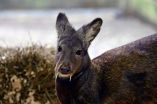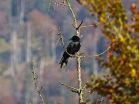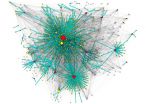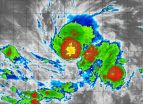(Press-News.org) CANCER RESEARCH UK scientists have found a drug combination that can trigger the self-destruct process in lung cancer cells - paving the way for new treatments, according to research that will be presented at the National Cancer Research Institute (NCRI) Cancer Conference in Liverpool next week*.
When healthy cells are no longer useful they initiate a chain of events culminating in self destruction. But cancer cells swerve away from this suicide path and become immortal. This means that cells grow out of control – causing tumours to form.
The Cancer Research UK team, based at the UCL Cancer Institute, has successfully fixed this fault in lung cancer cells – reprogramming the cells to self-destruct.
Using lung cancer cells and mice the scientists showed that the combination of two drugs, called TRAIL and a CDK9 inhibitor**, altered the molecular switches in the cell suicide process – forcing the cancer cells to self-destruct.
Lead researcher, Cancer Research UK scientist Professor Henning Walczak from the UCL Cancer Institute, said: "Igniting the fuse that causes lung cancer cells to self-destruct could pave the way to a completely new treatment approach – and leave healthy cells unharmed.
"The next step of our work will see how this approach works in other cancer types, and we hope it could ultimately lead to testing this technique in trials to see if it can help patients."
Nell Barrie, senior science information manager at Cancer Research UK, said: "This important research builds on the progress we've made to understand the routes cancer cells use to stay alive. Understanding and targeting these processes will move us closer to our goal of three out of four people beating cancer within the next 20 years.
"There's an urgent need to save more lives from lung cancer and we hope these findings will one day lead to effective new treatments to help lung cancer patients and potentially those with other cancer types too."
INFORMATION:
For media enquiries please contact Emily Head on 020 3469 6189 or, out-of-hours, the duty press officer on 07050 264 059.
Notes to editors:
* You can find the abstract for this research online: http://conference.ncri.org.uk/abstracts/2014/abstracts/LB052.html
** This drug combination is in early stage development to potentially treat non small cell lung cancer.
Video
Video available showing fluorescent cancer cells self-destructing after being treated with TRAIL: http://bit.ly/102K0AZ (please credit: "By courtesy of Professor Henning Walczak and Dr Nigel Waterhouse").
Scientists trigger self-destruct switch in lung cancer cells
2014-10-31
ELSE PRESS RELEASES FROM THIS DATE:
Tropical Depression Nuri now haunting the western Pacific Ocean
2014-10-31
Tropical Depression Nuri formed on Halloween morning, October 31, and is haunting the waters of the western North Pacific Ocean. NASA-NOAA's Suomi NPP satellite captured a ghostly-white image of the storm.
When Suomi NPP flew over Tropical Depression Nuri on Oct. 31 at 3:36 UTC, the Visible Infrared Imaging Radiometer Suite or VIIRS instrument aboard captured an infrared image of the storm. The infrared data shows temperature, an indicated that there were very high thunderstorms with very cold cloud top temperatures surrounding the center of the low level circulation ...
Strange, fanged deer persists in Afghanistan
2014-10-31
WCS study confirms that endangered musk deer still live in Nuristan Province – some 60 years after last sighting
Species targeted by poachers: Musk deer scent glands are more valuable than gold
Study appears in the October issue of the journal Oryx
NEW YORK (October 31, 2014) – More than 60 years after its last confirmed sighting, a strange deer with vampire-like fangs still persists in the rugged forested slopes of northeast Afghanistan according to a research team led by the Wildlife Conservation Society (WCS), which confirmed the species presence during ...
A matter of life and death: Cell death proteins key to fighting disease
2014-10-31
Melbourne researchers have uncovered key steps involved in programmed cell death, offering new targets for the treatment of diseases including lupus, cancers and neurodegenerative diseases.
The research teams from the Walter and Eliza Hall Institute worked together to discover the three-dimensional structure of a key cell death protein called Bak and reveal the first steps in how it causes cell death. Their studies were published in Molecular Cell and Proceedings of the National Academy of Sciences.
Programmed cell death, known as apoptosis, occurs naturally when ...
New step towards eradication of H5N1 bird flu
2014-10-31
A University of Adelaide-led project has developed a new test that can distinguish between birds that have been vaccinated against the H5N1 strain of avian influenza virus or "bird flu" with those that have been naturally infected.
This is a significant step in the fight against this often fatal strain of avian influenza which is widespread in the poultry populations of South East Asia, particularly Indonesia and Vietnam.
It causes global concern because of its possible transmission to humans and the threat of a pandemic if it mutates to a form that can be easily passed ...
'Divide and rule' -- raven politics
2014-10-31
Thomas Bugnyar and his team have been studying the behavior of approximately 300 wild ravens in the Northern Austrian Alps for years. They observed that ravens slowly build alliances through affiliative interactions such as grooming and playing. However, they also observed that these affiliative interactions were regularly interrupted by a third individual. Although in about 50 % of the cases these interventions were successful and broke up the two affiliating ravens, intervening can be potentially risky when the two affiliating ravens team up and chase away the intervening ...
Efficient genetic editing
2014-10-31
As potential next-generation therapeutics and research tools, few life sciences technologies hold more promise than genome-editing proteins – molecules that can be programmed to alter specific genes in order to treat or even cure genetic diseases.
There's at least one catch though – getting genome-editing proteins into cells, where they need to be to access the genome, is a major challenge, especially in live animals or human patients.
Conventionally, researchers have delivered the DNA encoding these genome-editing proteins into cells and then relied on ...
Countries can learn from Cyprus' 2013 economic crash, according to Imperial report
2014-10-31
In March 2013, Cyprus agreed to a €17 billion (£13.42 billion) international bailout by the International Monetary Fund (IMF), the European Central Bank (ECB) and the European Commission (EC).
The magnitude of the bailout was 100 per cent of Gross Domestic Product (GDP) and also involved a bank bail in. This is when the borrower's creditors are forced to bear some of the burden by having a portion of their debt written off in order for the bank to have sustainable level of debt.
The package of measures was aimed at preventing the country from facing the ...
Tweet much to gain popularity is an inefficient strategy
2014-10-31
The imbalanced structure of Twitter, where some users have many followers and the large majority barely has several dozen followers, means that messages from the more influential have much more impact. Less popular users can compensate for this by increasing their activity and their tweets, but the outcome is costly and inefficient. This was confirmed by an analysis of the social network performed by researchers from the Technical University of Madrid.
What can Twitter users do to increase their influence? To answer this question, a team of researchers at the Technical ...
Tropical Storm Vance's center looks like a pumpkin to NASA's Terra satellite
2014-10-31
Tropical Depression 21E strengthened overnight on Oct. 30 and by Halloween morning, Tropical Storm Vance was haunting the waters of the Eastern Pacific Ocean. In a false-colored infrared image from NASA's Terra satellite on Oct. 31, the strong thunderstorms around the center resemble a pumpkin.
Tropical Depression 21E formed on Oct. 30 after struggling for days as a low pressure area. Just a day later it strengthened into a tropical storm and was renamed Vance.
NASA's Terra satellite passed over Vance on October 31 at 4:55 UTC (12:55 a.m. EDT) – the witching hour ...
Raising cryptography's standards
2014-10-31
Most modern cryptographic schemes rely on computational complexity for their security. In principle, they can be cracked, but that would take a prohibitively long time, even with enormous computational resources.
There is, however, another notion of security — information-theoretic security — which means that even an adversary with unbounded computational power could extract no useful information from an encrypted message. Cryptographic schemes that promise information-theoretical security have been devised, but they're far too complicated to be practical.
In ...





